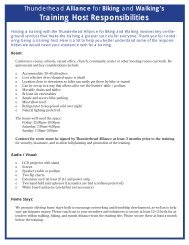2007 Benchmarking Report - Alliance for Biking & Walking
2007 Benchmarking Report - Alliance for Biking & Walking
2007 Benchmarking Report - Alliance for Biking & Walking
Create successful ePaper yourself
Turn your PDF publications into a flip-book with our unique Google optimized e-Paper software.
to bicycle and pedestrian programs. On average, state Departments<br />
of Transportation (DOTs) employ 0.3 FTE staff per one<br />
million people in their state. The rate is higher among cities,<br />
which average 2.8 FTE bicycle and pedestrian staff per million<br />
people. DOTs were also surveyed on Safe Routes to School staffing,<br />
and responses indicate that while most states average just<br />
one FTE staff person dedicated to Safe Routes to School, some<br />
states have more than one and a few report no dedicated staff at<br />
this time. Some states use innovative mechanisms <strong>for</strong> increasing<br />
Safe Routes to School staffing capacity.<br />
Bicycle and Pedestrian Infrastructure<br />
City Surveys asked cities to report miles of existing<br />
and planned facilities including sidewalks, on-street striped bike<br />
lanes, multi-use paths, and signed bike routes. The resulting<br />
data show that cities average 1.23 miles of bicycling facilities<br />
per square mile. Cities plan to double bicycle and pedestrian<br />
facilities, on average. Cities were also asked to report the number<br />
of existing bicycle racks and spaces per rack. The average<br />
number of bike parking spaces per 10,000 people is 24 spaces.<br />
The amount of bicycle parking varied greatly, with some cities<br />
reporting no bicycle parking and some cities reporting relatively<br />
large number of bike parking spaces.<br />
Bike-Transit Integration<br />
To measure how well cities integrate cycling and transit,<br />
City and State Surveys collected data on bike parking at transit<br />
stops, bike racks on buses, and hours per week bicycles are allowed<br />
on trains. Most cities rank well regarding bike-bus integration<br />
by providing bike racks on 100% of city buses, but many<br />
ranked low on parking <strong>for</strong> cyclists at transit stops. Cities averaged<br />
1.7 bike parking spaces per 10,000 residents at transit stops<br />
and hubs. While data <strong>for</strong> bike access on trains was sparse, cities<br />
that did report allow bikes on trains <strong>for</strong> an average of 137 hours<br />
per week (out of a total of 168 ). Thirty percent of cities reported<br />
that bikes are allowed on trains at all hours of the day.<br />
Thunderhead <strong>Alliance</strong> Advocacy Organizations<br />
The number of Thunderhead <strong>Alliance</strong> state and local<br />
bicycle and pedestrian advocacy organizations has been increasing<br />
steadily since Thunderhead was founded in 1996. This re-<br />
port<br />
measures organization capacity of Thunderhead T<br />
<strong>Alliance</strong><br />
member organizations and determines standards <strong>for</strong> membership,<br />
revenue, staffing and media exposure. Results from<br />
Thunderhead Organization Surveys vary widely because of the<br />
great variation in maturity and operations of these organizations<br />
as well as the communities they serve. Some organizations in<br />
this report are decades old while others were founded not long<br />
be<strong>for</strong>e Thunderhead began this report.<br />
Survey responses indicate that state-wide organizations<br />
operate on three cents per state resident (on average). Organizations<br />
representing cities earn 11 cents per resident (3.7 times<br />
the amount earned by state-wide counterparts). The revenue<br />
sources of Thunderhead organizations are diversified and composed<br />
primarily of membership and donations, program fees<br />
and events, and government grants and contracts. Organizations<br />
take in a relatively small amount of funds from foundation grants<br />
and an even smaller amount from bike shops and manufacturers.<br />
Looking at membership rates, state-wide organizations average<br />
one member per 56,579 residents and organizations representing<br />
cities have higher rates with one member per 11,100 residents.<br />
When comparing staffing levels, city organizations again<br />
have a higher rate averaging 1.6 FTE staff per million people<br />
while state-wide organizations average 0.4 FTE staff per million<br />
residents.<br />
Factors Influencing Cycling, <strong>Walking</strong> and Safety<br />
This report examines the relationship between biking<br />
and walking levels, safety, and a number of environmental and<br />
demographic variables. The environmental factors considered<br />
included weather, residential density, and cycling infrastructure.<br />
While weather seems to have little impact on cycling<br />
levels, residential density and cycling facilities may be positively<br />
linked to cycling levels. Denser cities also have higher<br />
levels of cycling and walking on average (r = 0.69)(1). Cities<br />
with more miles of cycling facilities per square mile generally<br />
have higher levels of cycling (r=0.50).<br />
(1) “r” refers to the correlation coeffi cient, a measure of the interdependence of two variables where +1 equals a perfect positive correlation, -1 equals a perfect negative correlation,<br />
and 0 is the absence of correlation.<br />
EXECUTIVE SUMMARY<br />
9<br />
Bicycling & <strong>Walking</strong> in the U.S./ Thunderhead <strong>Alliance</strong> <strong>2007</strong>



